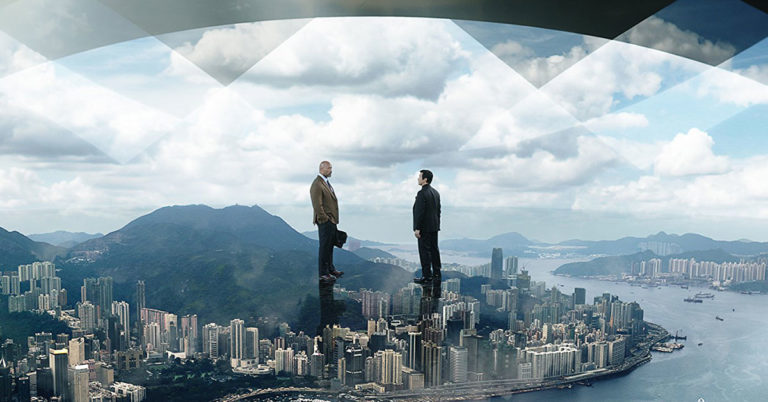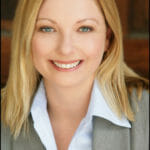By Shanee Edwards · July 16, 2018

The new action/thriller Skyscraper is one giant adrenaline rush. Writer/director Rawson Marshall Thurber shared with us the clever way he structured his story for maximum bang.
Set in Hong Kong, Skyscraper is about the tallest, most secure building on the planet. Our protagonist is Will Sawyer (Dwayne Johnson), a former military serviceman and amputee who moves his wife Sarah (Neve Campbell), and their two small children into this futuristic behemoth called The Pearl after being hired to run its security department. When Thurber (We’re the Millers, The Mysteries of Pittsburgh), set out to write this screenplay, the first thing he did was brainstorm several set pieces. If you’re not sure what a set piece is, it’s a major scene in a film that’s set in one specific location that serves as an engine for creating comedy or action. A set piece is part of the larger narrative that will often set up elements that will be paid off later in the story or pays off elements set up earlier in the story.
When Thurber (We’re the Millers, The Mysteries of Pittsburgh), set out to write this screenplay, the first thing he did was brainstorm several set pieces. If you’re not sure what a set piece is, it’s a major scene in a film that’s set in one specific location that serves as an engine for creating comedy or action. A set piece is part of the larger narrative that will often set up elements that will be paid off later in the story or pays off elements set up earlier in the story.
Some examples of set pieces are the Mount Rushmore chase scene in North by Northwest, the Met-Gala Ball in Oceans 8, the beauty pageant in Little Miss Sunshine, the bathroom scene with Bryan Cranston in Why Him? and the dance scene at Griffith Observatory in La La Land. Many comedy and action writers rely on set pieces, not character, to write their screenplays.
“I’d like to say,” says Thurber, “that I start with character first and character drives the story, but that’s not always the case for me. I thought about what a scary setting might be, what the opening scene might be. I liked the idea of a cold open where the hero fails. I sort of mull it around in my head and the characters start to come to life. Then the characters start informing the story. I write sequentially, from beginning to end. I don’t outline to death but I definitely have quite a few pages written that are a pretty clear roadmap of where I want to go.” Here are the five set-pieces Thurber created for Skyscraper.
Here are the five set-pieces Thurber created for Skyscraper.
One of the many amenities at The Pearl is a park and botanical garden located in the middle of the tower.
“I knew that what I wanted to do was essentially make a vertical city and create a space for incredible action,” says Thurber. “We have this 30-story vertical park 100 floors up. I thought wouldn’t it be great to have a forest fire in the middle of the sky, sort of Bambi-style?” Because the park is so high up in the air, this set piece adds a second layer of terror to the action. A forest fire is dangerous; one a hundred stories up is perilous.
Because the park is so high up in the air, this set piece adds a second layer of terror to the action. A forest fire is dangerous; one a hundred stories up is perilous.
This is standard action fare. Vertigo is a great example of a film that uses height to create danger. Die Hard is another. Only The Pearl is so incredibly high, it adds a bit of novelty to this common trope.
These turbines create a new type of physical obstacle for the hero, who basically has to get his large, injured body past two giant eggbeaters. It’s a delicate affair that needs to be timed just right.
“The Pearl at the top is kind of a mystery. I loved The Lady from Shanghai and Enter the Dragon so I wanted to do a mirror shootout.“ In the film, The Pearl’s walls can change their appearance. They can look invisible or become mirrors.
This is another common action trope that is meant to test the hero. Usually, there is a loved one inside.
When you string all these set pieces together, the story almost writes itself.
Well, almost.
“None of it’s easy,” says Thurber. “I think if you met a screenwriter who said ‘oh, it’s easy’ that’s probably a bad screenwriter.” He says the challenge isn’t just to create thrilling set pieces but also to ensure the tension and stakes rise with each one.
He says the challenge isn’t just to create thrilling set pieces but also to ensure the tension and stakes rise with each one.
“You want to keep it thrilling and very taught. You always want rising action in the sequences, and typically, the best action sequences have character and choice built into them. Otherwise, it’s just noise. You want the action sequence to complicate and rise, and rise to a resolution. Similarly, if you were to sort of zoom out from that, each action sequence rises, but the entire picture must also rise. So you want to pace out your action set pieces in such a way that they keep getting better and better.”
Thurber says never to put your best action sequence in the first act. “You want to end with a bang, not a whimper. You want it to keep getting more interesting, more clever and more exciting all the way to the end. There’s a reason Star Wars doesn’t end with the Death Star exploding.”
Skyscraper opened on July 13, 2018.
 Shanee Edwards graduated from UCLA Film School with an MFA in Screenwriting and is currently the film critic for SheKnows.com. She recently won the Next MacGyver television writing competition to create a TV show about a female engineer. Her pilot, Ada and the Machine, is currently in development with America Ferrera’s Take Fountain Productions. You can follow her on Twitter: @ShaneeEdwards
Shanee Edwards graduated from UCLA Film School with an MFA in Screenwriting and is currently the film critic for SheKnows.com. She recently won the Next MacGyver television writing competition to create a TV show about a female engineer. Her pilot, Ada and the Machine, is currently in development with America Ferrera’s Take Fountain Productions. You can follow her on Twitter: @ShaneeEdwards
Photo credit: Universal
For all the latest from The Script Lab, be sure to follow us on Twitter, Facebook, and Instagram.